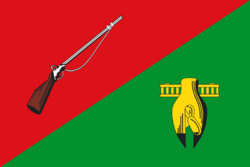Stary Oskol
Stary Oskol (Russian: Старый Оскол, IPA: [ˈstarɨj ɐˈskol]) is a city in Belgorod Oblast, Russia, located 618 kilometers (384618 kilometers (384 mi) south of Moscow, on the Oskol River. Population: 221,085 (2010 Census);[1] 215,898 (2002 Census);[2] 173,917 (1989 Census).[3]



History
changeIt was founded in 1593[4] as a fortress, a part of the southern fortification line around Moscow. In the 17th century, the town was sacked by Crimean Tatars. Later it was affected by the Russian Civil War in 1919, as well as by World War II, where it was captured by Hungarian troops. After World War II, industry developed in the city and its population started to grow.
Administrative and municipal status
changeWithin the framework of administrative divisions, Stary Oskol serves as the administrative center of Starooskolsky District, even though it is not a part of it. As an administrative division, it is incorporated separately as the town of oblast significance of Stary Oskol—an administrative unit with a status equal to that of the districts.[5] As a municipal division, the territories of the city of oblast significance of Stary Oskol and of Starooskolsky District are incorporated as Starooskolsky Urban Okrug.[6]
Economy
changeStary Oskol is an important center of iron ore mining, situated at the border of the Kursk Magnetic Anomaly, one of the largest deposits of iron ore worldwide. Over eight million tons of iron ore are mined here per year. For this reason there is also a branch of the Moscow Institute of Steel and Alloys in the city.
Education
changeOne of the oldest kids music schools in the city is located in the city center, on Lenina Street.
Notable people
change- Alexander Emelianenko, mixed martial artist
- Fedor Emelianenko, mixed martial artist
- Denis Lebedev, boxer
- Kirill Sidelnikov, mixed martial artist
International relations
changeTwin towns and sister cities
changeStary Oskol is twinned with:
- Salzgitter, Germany (1987)
- Asenovgrad, Bulgaria (1989)
- Mänttä, Finland (1989)
References
changeNotes
change- ↑ Всероссийская перепись населения 2010 года. Том 1 [2010 All-Russian Population Census, vol. 1]. Всероссийская перепись населения 2010 года (2010 All-Russia Population Census) (in Russian). Federal State Statistics Service. 2011. Retrieved June 29, 2012.
- ↑ Численность населения России, субъектов Российской Федерации в составе федеральных округов, районов, городских поселений, сельских населённых пунктов – районных центров и сельских населённых пунктов с населением 3 тысячи и более человек [Population of Russia, its federal districts, federal subjects, districts, urban localities, rural localities—administrative centers, and rural localities with population of over 3,000]. Всероссийская перепись населения 2002 года (All-Russia Population Census of 2002) (in Russian). Federal State Statistics Service. May 21, 2004. Retrieved 9 Feb 2012.
- ↑ Demoscope Weekly (1989). Всесоюзная перепись населения 1989 г. Численность наличного населения союзных и автономных республик, автономных областей и округов, краёв, областей, районов, городских поселений и сёл-райцентров. [All Union Population Census of 1989. Present population of union and autonomous republics, autonomous oblasts and okrugs, krais, oblasts, districts, urban settlements, and villages serving as district administrative centers]. Всесоюзная перепись населения 1989 года (All-Union Population Census of 1989) (in Russian). Institute of Demographics of the State University—Higher School of Economics. Retrieved 9 Feb 2012.
- ↑ Charter of Starooskolsky Urban Okrug
- ↑ Law #248
- ↑ Law #159
Other websites
change- Stary Oskol on mojgorod.ru (in Russian)
- Twin towns of Stary Oskol Archived 2016-03-13 at the Wayback Machine (in Russian)